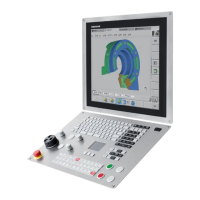DIN/ISO programming | Contour-based turning cycles
4
332
HEIDENHAIN | User's Manual smart.Turn and DIN Programming | 12/2017
V: Machine form elements (default: 0)
A chamfer/rounding arc is machined
0: At beginning and end
1: At beginning
2: At end
3: No machining
O: Recessing feed (default: active feed rate)
E: Finishing feed
B: Offset width (default: 0)
XA, ZA: Start point blank (definition of corner point of workpiece
blank contour – evaluation only if no workpiece blank has been
defined)
XA, ZA not programmed: The workpiece blank contour is
calculated from the tool position and the ICP contour
XA, ZA programmed: Definition of the corner point of the
workpiece blank
The control uses the tool definition to distinguish between radial and
axial recesses.
Program at least one contour reference (e.g.: NS or NS, NE) and P.
Depth compens. R: Depending on factors such as workpiece material
or feed rate, the tool tip is displaced during a turning operation.
You can correct the resulting infeed error with the turning depth
compensation factor. The value is usually determined empirically.
Offset width B: After the second infeed movement, during the
transition from turning to recessing, the path to be machined is
reduced by Offset width B. Each time the system switches on this
side, the path is reduced by B – in addition to the previous offset.
The total offset is limited to 80 % of the effective cutting width
(effective cutting width = cutting width – 2*cutting radius). If required,
the control reduces the programmed offset width. After clearance
roughing, the remaining material is removed with a single cut.
The tool radius compensation is active
A G57 oversize enlarges the contour (also inside
contours).
A G58 oversize
>0: Enlarges the contour
<0: Is not offset
G57/G58 oversizes are deleted after cycle end

